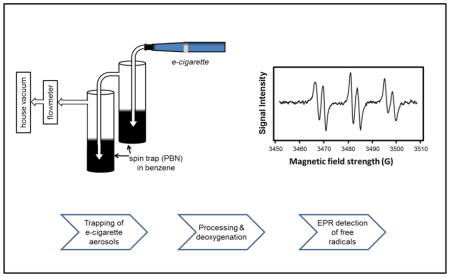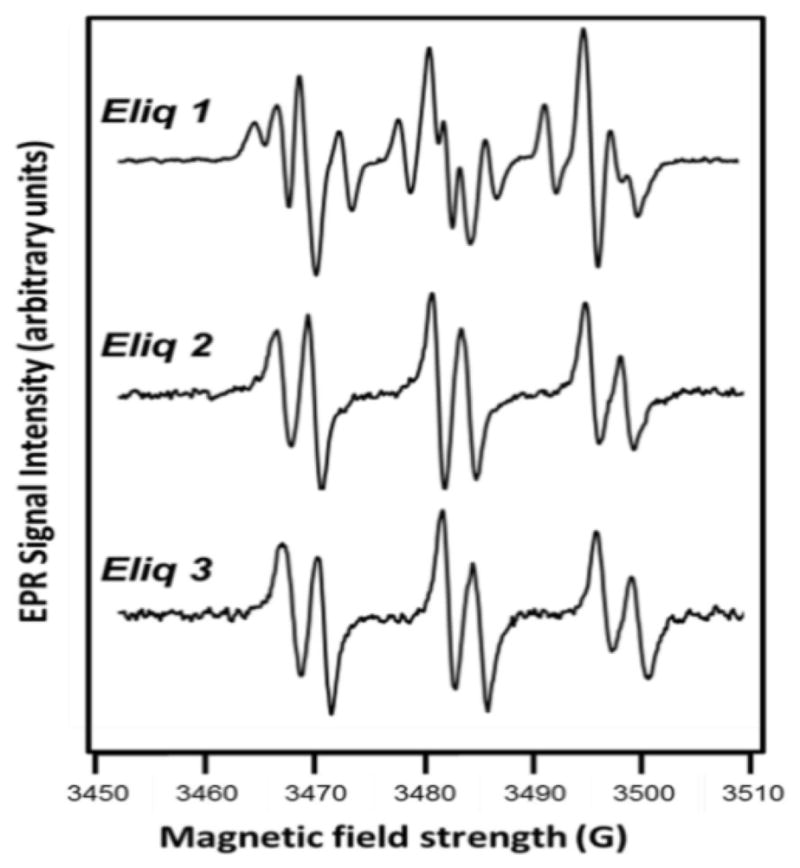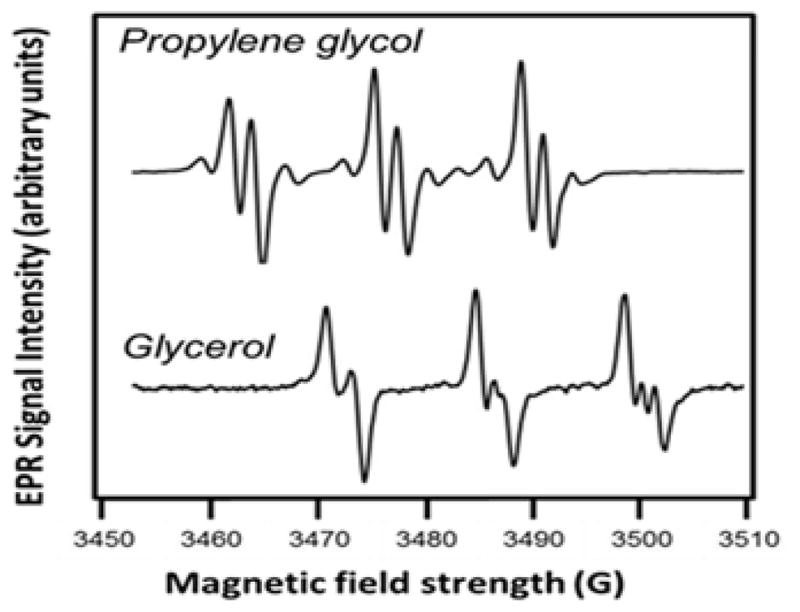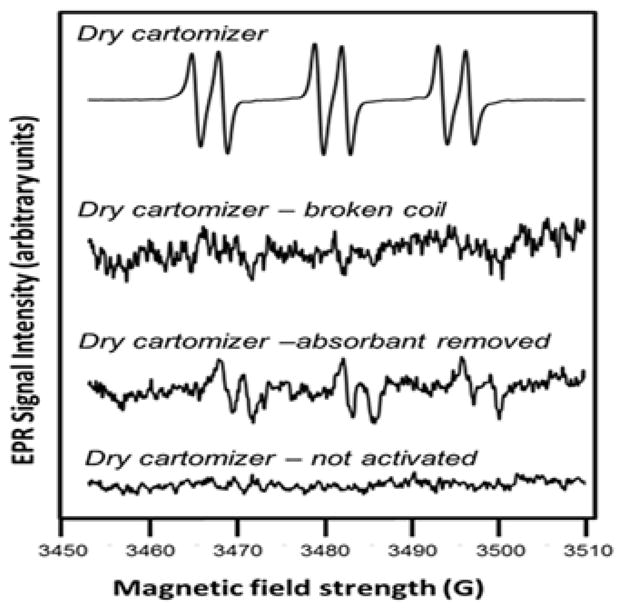Abstract
Electronic cigarette (EC) usage has increased exponentially, but limited data is available on its potential harmful effects. We tested for the presence of reactive, short-lived free radicals in EC aerosols by electron paramagnetic resonance spectroscopy (EPR) using the spin-trap phenyl-N-tert-butylnitrone (PBN). Radicals were detected in aerosols from all ECs and eliquids tested (2.5×1013 to 10.3×1013 radicals per puff at 3.3V) and from eliquid solvents propylene glycol and glycerol and from “dry puffing”. These results demonstrate, for the first time, the production of highly oxidizing free radicals from ECs which may present a potential toxicological risk to EC users.
Graphical abstract

Electronic cigarettes (EC) are battery-powered devices that deliver nicotine without burning tobacco.1–3 Although often marketed and perceived as a less harmful alternative to conventional cigarettes, there is currently a lack of clear, comprehensive, quantitative evidence on the toxicants in EC aerosols.
Cigarette smoke contains high concentrations of toxic free radicals (>1016 molecules/puff) including reactive oxygen species (ROS) and reactive nitrogen species (RNS).4, 5 Oxidative stress due to exposure to cigarette smoke free radicals has widespread impact on many critical cellular pathways including cell proliferation, metabolism, survival and inflammation. Oxidative stress/damage resulting from exposure to these free radicals is likely an important mechanism by which smoking induces diseases such as cancer,6 cardiovascular disease 7 and chronic obstructive pulmonary disease (COPD).8–10 While recent studies have pointed to the possible production of stable, long-lived radicals by EC;11–13 there is no data on the production of short-lived, highly reactive radicals. Our current aim was to determine if such radicals are present in EC aerosols by using electron paramagnetic resonance (EPR) with spin trapping, the only direct method for detecting such radicals.14, 15
Aerosols were generated (Figure S1, described in detail in the Supporting Information) using commercially available EC batteries (eGo-ce4 3.3 V and Tesla 3.0–6.0 V), cartomizer (SmokTech: XXL, 1.5 ohms resistance, dual heating coils) and eliquids as well as their solvents propylene glycol and glycerol. Puffs were simulated based on human usage conditions16 (puff duration, 5 sec; puff interval, 20 sec; flow rate, 500 ml/min and number of puffs, 40 per experiment). EC aerosols were passed through two impingers (approx. 20 cm downstream) containing a benzene solution with the spin-reagent trap phenyl-N-tert-butylnitrone (PBN). PBN-radical adducts were then analyzed using EPR.14, 15, 17, 18
EPR spectra clearly indicate the presence of PBN spin adducts in aerosols generated from all eliquids and voltages tested indicating the presence of short-lived free radicals (Figure 1). Both eliquid 2 and eliquid 3 yielded characteristic 6-line EPR spectra (aN = 14.05 G, aH = 2.21 G, and aN = 14.17 G, aH = 2.47 G, respectively), suggesting the presence of a sole, dominant PBN radical adduct at the time of analysis. This does not preclude the possibility that multiple radical species were generated during the experiment. In contrast, eliquid 1 yielded a PBN-adduct spectrum characteristic of multiple trapped radical species. At a potential of 3.3 V, radical production was estimated to be 10.3, 4.0 and 2.5 × 1013 radicals per puff (calculated from 40 cumulative puffs) for eliquids 1, 2 and 3, respectively. These values are 100- to 1000-fold lower than those measured previously in mainstream smoke from conventional cigarettes.4, 5 A direct comparison is difficult since puff profiles differ greatly between the two products, with EC users tending to take larger, longer puffs with a slower flow rate than conventional cigarette smokers.16, 19 Extrapolating from the results, an EC user taking 200 puff per day20 or vaping 25 times per day (from data in Kosmider et al16) would result in 2 × 1015 radials per day. Free radical exposure from air pollution (PM2.5) has been estimated to be about 2 × 1014 per day.21 This would indicate that exposure from E-cig use can be 10-fold greater than from air pollution. When aerosols were collected in the absence of PBN (i.e., benzene only) and subjected to EPR in order to determine the presence of less-reactive, long-lived radials, no EPR signals were observed (data not shown). This finding suggests that detectible levels of stable radicals were not present in the e-liquid aerosols.
Figure 1.

Highly reactive free radicals in e-cigarette (EC) aerosols. Representative EPR spectra obtained from commercially available eliquids at 3.3 V.
Most eliquids contain the solvents propylene glycol (PG) and/or glycerol, with nicotine and flavorings at levels that vary considerably.22–24 We examined if these EC solvents, themselves, may be a source of free radicals in EC aerosols. In aerosols generated from both propylene glycol and glycerol, distinct PBN radical adducts were observed (Figure 2). The EPR profiles differed between the two solvents, suggesting two discrete types of radicals. At a potential of 3.3 V, radical production was estimated to be 3.9 × 1013 and 2.2 × 1013 radicals per puff for PG and glycerol, respectively. No EPR spectra were observed in the absence of PBN suggesting the absence of long-lived radicals. It is not known to what extent radicals generated from these solvents correspond to the radical profiles of the eliquids tested.
Figure 2.

Highly reactive free radicals obtained from e-cigarettes using eliquid solvents. Representative EPR spectra from propylene glycol or glycerin at 3.3 V.
The EC cartomizer chamber contains absorbent and wicking materials that deliver eliquid to the heating element. “Dry puffing” can occur where the wick is not sufficiently supplied with eliquid prior to puff initiation as a result of an empty cartomizer or overheating of the coil in the process of normal usage. When dry puffing conditions were simulated using an empty cartomizer PBN spin adducts were observed suggesting the presence of trapped radicals (Figure 3). At a potential of 3.3 V, radical production was estimated to be 10.2 × 1013 radicals per puff. These radicals were not observed when the heating element was severed, battery was turned off, or absorbent and wicking materials were removed from the cartomizer prior to the experiment. These findings suggest the production of radicals from the heating/burning of the dry wicking material by the heating element.
Figure 3.

Free radicals derived from from “dry puffing”. Representative EPR spectra obtained under “dry puffing” conditions with an intact cartomizer or with cartomizers that had the heating mechanism disabled, absorbent material removed or not activated.
There is limited data available on the nature of thermal degradation products and the toxicity of inhaled aerosols of compounds present in EC. This study adds reactive free radicals to the list of potentially toxic products which have been found in EC aerosols. As described above, damage from these radicals has been implicated as an important causal factor in a variety of tobacco related diseases and disorders. However, there is currently insufficient data to determine the potential harm from exposure to EC-generated radicals. Additional data on the levels of exposure and the types of radicals would be required. Since the overall levels of radicals are significantly lower than those observed in conventional cigarette smoke, it might be expected that the degree of damage might be less, but this depends on the identity and reactivity of the specific radicals produced.
Supplementary Material
Acknowledgments
Funding Sources
This work was supported in part by the National Institute on Drug Abuse of the National Institutes of Health and the Center for Tobacco Products of the U.S. Food and Drug Administration (under Award Number P50-DA-036107).
ABBREVIATIONS
- EC
electronic cigarettes
- EPR
electron paramagnetic resonance
- PBN
phenyl-N-tert-butylnitrone
- ROS
reactive oxygen species
- RNS
reactive nitrogen species
- COPD
chronic obstructive pulmonary disease
Footnotes
Author Contributions
All authors have given approval to the final version of the manuscript.
The content is solely the responsibility of the authors and does not necessarily represent the official views of the National Institutes of Health or the Food and Drug Administration.
Supporting Information. A detailed description of the materials and methods is provided. This material is available free of charge via the Internet at http://pubs.acs.org.
References
- 1.Yingst JM, Veldheer S, Hrabovsky S, Nichols TT, Wilson SJ, Foulds J. Factors Associated With Electronic Cigarette Users’ Device Preferences and Transition From First Generation to Advanced Generation Devices. Nicotine Tob Res. 2015 doi: 10.1093/ntr/ntv052. [DOI] [PMC free article] [PubMed] [Google Scholar]
- 2.Talih S, Balhas Z, Eissenberg T, Salman R, Karaoghlanian N, El Hellani A, Baalbaki R, Saliba N, Shihadeh A. Effects of user puff topography, device voltage, and liquid nicotine concentration on electronic cigarette nicotine yield: measurements and model predictions. Nicotine Tob Res. 2015;17:150–157. doi: 10.1093/ntr/ntu174. [DOI] [PMC free article] [PubMed] [Google Scholar]
- 3.Brown CJ, Cheng JM. Electronic cigarettes: product characterisation and design considerations. Tob Control. 2014;23(Suppl 2):ii4–10. doi: 10.1136/tobaccocontrol-2013-051476. [DOI] [PMC free article] [PubMed] [Google Scholar]
- 4.Dellinger B, Khachatryan L, Masko S, Lomnicki S. Free Radicals in Tobacco Smoke. Mini-Rev Org Chem. 2011;8:427–433. [Google Scholar]
- 5.Bartalis J, Chan WG, Wooten JB. A new look at radicals in cigarette smoke. Anal Chem. 2007;79:5103–5106. doi: 10.1021/ac070561+. [DOI] [PubMed] [Google Scholar]
- 6.Pryor WA. Cigarette smoke radicals and the role of free radicals in chemical carcinogenicity. Environ Health Perspect. 1997;105(Suppl 4):875–882. doi: 10.1289/ehp.97105s4875. [DOI] [PMC free article] [PubMed] [Google Scholar]
- 7.Messner B, Bernhard D. Smoking and cardiovascular disease: mechanisms of endothelial dysfunction and early atherogenesis. Arterioscler Thromb Vasc Biol. 2014;34:509–515. doi: 10.1161/ATVBAHA.113.300156. [DOI] [PubMed] [Google Scholar]
- 8.How Tobacco Smoke Causes Disease: The Biology and Behavioral Basis for Smoking-Attributable Disease: A Report of the Surgeon General. Atlanta, GA: 2010. [PubMed] [Google Scholar]
- 9.Domej W, Oettl K, Renner W. Oxidative stress and free radicals in COPD--implications and relevance for treatment. Int J Chron Obstruct Pulmon Dis. 2014;9:1207–1224. doi: 10.2147/COPD.S51226. [DOI] [PMC free article] [PubMed] [Google Scholar]
- 10.Kirkham P, Rahman I. Oxidative stress in asthma and COPD: Antioxidants as a therapeutic strategy. Pharmacol Therapeut. 2006;111:476–494. doi: 10.1016/j.pharmthera.2005.10.015. [DOI] [PubMed] [Google Scholar]
- 11.Lerner CA, Sundar IK, Watson RM, Elder A, Jones R, Done D, Kurtzman R, Ossip DJ, Robinson R, McIntosh S, Rahman I. Environmental health hazards of e-cigarettes and their components: Oxidants and copper in e-cigarette aerosols. Environ Pollut. 2015;198C:100–107. doi: 10.1016/j.envpol.2014.12.033. [DOI] [PMC free article] [PubMed] [Google Scholar]
- 12.Lerner CA, Sundar IK, Yao H, Gerloff J, Ossip DJ, McIntosh S, Robinson R, Rahman I. Vapors produced by electronic cigarettes and e-juices with flavorings induce toxicity, oxidative stress, and inflammatory response in lung epithelial cells and in mouse lung. PloS one. 2015;10:e0116732. doi: 10.1371/journal.pone.0116732. [DOI] [PMC free article] [PubMed] [Google Scholar]
- 13.Sussan TE, Gajghate S, Thimmulappa RK, Ma J, Kim JH, Sudini K, Consolini N, Cormier SA, Lomnicki S, Hasan F, Pekosz A, Biswal S. Exposure to electronic cigarettes impairs pulmonary anti-bacterial and anti-viral defenses in a mouse model. PloS one. 2015;10:e0116861. doi: 10.1371/journal.pone.0116861. [DOI] [PMC free article] [PubMed] [Google Scholar]
- 14.Church DF. Spin-Trapping Organic Radicals. Anal Chem. 1994;66:A418–A427. [Google Scholar]
- 15.Hawkins CL, Davies MJ. Detection and characterisation of radicals in biological materials using EPR methodology. BBA-Gen Subjects. 2014;1840:708–721. doi: 10.1016/j.bbagen.2013.03.034. [DOI] [PubMed] [Google Scholar]
- 16.Farsalinos KE, Romagna G, Tsiapras D, Kyrzopoulos S, Voudris V. Evaluation of electronic cigarette use (vaping) topography and estimation of liquid consumption: implications for research protocol standards definition and for public health authorities’ regulation. Int J Environ Res Public Health. 2013;10:2500–2514. doi: 10.3390/ijerph10062500. [DOI] [PMC free article] [PubMed] [Google Scholar]
- 17.Baum SL, Anderson IGM, Baker RR, Murphy DM, Rowlands CC. Electron spin resonance and spin trap investigation of free radicals in cigarette smoke: development of a quantification procedure. Anal Chim Acta. 2003;481:1–13. [Google Scholar]
- 18.Yu LX, Dzikovski BG, Freed JH. A protocol for detecting and scavenging gas-phase free radicals in mainstream cigarette smoke. JoVE. 2012:e3406. doi: 10.3791/3406. [DOI] [PMC free article] [PubMed] [Google Scholar]
- 19.Spindle TR, Breland AB, Karaoghlanian NV, Shihadeh AL, Eissenberg T. Preliminary Results of an Examination of Electronic Cigarette User Puff Topography: The Effect of a Mouthpiece-Based Topography Measurement Device on Plasma Nicotine and Subjective Effects. Nicotine Tob Res. 2014 doi: 10.1093/ntr/ntu186. [DOI] [PMC free article] [PubMed] [Google Scholar]
- 20.Dawkins L, Turner J, Roberts A, Soar K. ‘Vaping’ profiles and preferences: an online survey of electronic cigarette users. Addiction. 2013;108:1115–1125. doi: 10.1111/add.12150. [DOI] [PubMed] [Google Scholar]
- 21.Gehling W, Dellinger B. Environmentally persistent free radicals and their lifetimes in PM2.5. Environ Scien & tech. 2013;47:8172–8178. doi: 10.1021/es401767m. [DOI] [PMC free article] [PubMed] [Google Scholar]
- 22.Cheng TR. Chemical evaluation of electronic cigarettes. Tob Control. 2014;23:11–17. doi: 10.1136/tobaccocontrol-2013-051482. [DOI] [PMC free article] [PubMed] [Google Scholar]
- 23.Geiss O, Bianchi I, Barahona F, Barrero-Moreno J. Characterisation of mainstream and passive vapours emitted by selected electronic cigarettes. Int J Hyg Environ Health. 2015;218:169–180. doi: 10.1016/j.ijheh.2014.10.001. [DOI] [PubMed] [Google Scholar]
- 24.Long GA. Comparison of select analytes in exhaled aerosol from e-cigarettes with exhaled smoke from a conventional cigarette and exhaled breaths. Int J Environ Res Public Health. 2014;11:11177–11191. doi: 10.3390/ijerph111111177. [DOI] [PMC free article] [PubMed] [Google Scholar]
Associated Data
This section collects any data citations, data availability statements, or supplementary materials included in this article.


